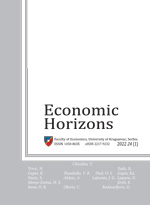
THE JOURNAL IS PUBLISHED
THREE TIMES A YEAR
in April, August and December
Marko Đogo1, Dragan Gligorić2 and Marianne Berecz3
1University of East Sarajevo, Faculty of Economics Pale, Bosnia and Herzegovina
2University of Banja Luka, Faculty of Economics, Bosnia and Herzegovina
3Ministry of Foreign Affairs of Hungary, Budapest, Hungary
With its nominal GDP USD 177.3 billion in 2022, the Hungarian economy is roughly equivalent to the economies of Serbia, Croatia and Slovenia, combined. Yet, these three countries are among the five most important Bosnia and Herzegovina’s (B&H) trading partners in exports and imports, while Hungary only ranks eighth among B&H’s most significant trading partners. By applying the gravity model, it was found that the basic gravity model (which takes into account only the size of the economy and the distance) is insufficient to explain the volume of trade between Bosnia and Herzegovina and Hungary. Actually, the fact that Bosnia and Herzegovina was once a member state of the Former Yugoslavia still has a significant impact on explaining the international trade of Bosnia and Herzegovina, simultaneously indicating the importance of historical, cultural, and political ties between the countries. The results obtained in this research study pertaining to the ten most significant trading partners of Bosnia and Herzegovina also suggest that the distance between the major cities more strongly influences exports than imports. Taking into consideration the size of the Hungarian economy and the distance, these results suggest that the trade volume between Bosnia and Herzegovina and Hungary is far below the expected level.
Keywords:
JEL Classification:
Since March 2015, the Journal is indexed in DOAJ
Since November 2013, the Journal is indexed in ProQuest – ABI/INFORM
Since October 2013, the Journal is indexed in Cabell’s Directories
Since September 2013, the Journal is indexed in Index Copernicus Journals Master List 2012
Since March 2013, the Journal has been evaluated and accepted for listing in EconLit (American Economic Association Publications)
Since January 2013, the Journal has been included into EBSCO’s databases
Since November 2012, the Journal has been included into Ulrich’s Periodicals Directory
Since March 2015, the Journal is indexed in DOAJ
Since November 2013, the Journal is indexed in ProQuest – ABI/INFORM
Since October 2013, the Journal is indexed in Cabell’s Directories
Since September 2013, the Journal is indexed in Index Copernicus Journals Master List 2012
Since March 2013, the Journal has been evaluated and accepted for listing in EconLit (American Economic Association Publications)
Since January 2013, the Journal has been included into EBSCO’s databases
Since November 2012, the Journal has been included into Ulrich’s Periodicals Directory